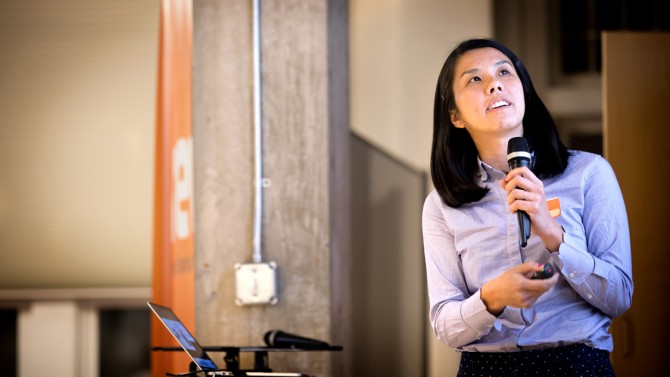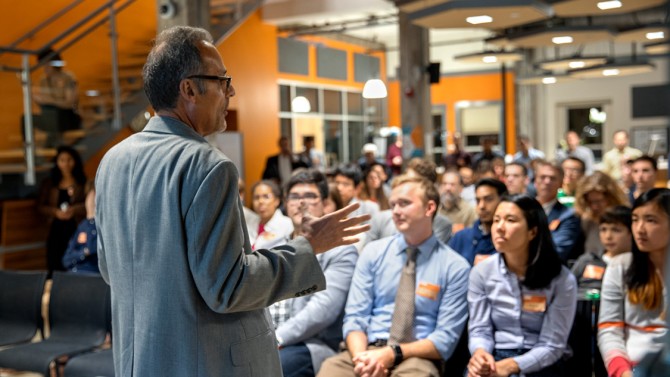Lab innovations translate into real-world business impact
By Susan Kelley
Imagine being able to take a selfie with the sun in the background – and capture not only an image of yourself, but also of every single sunspot in exquisite detail.
That’s what graduate student Kayla Nguyen, M.S. ’14, has done for electron microscopy – and Apple, Intel and the Howard Hughes Medical Institute have expressed interest. “This is a groundbreaking, new way to visualize data,” she said.
Nguyen and five other engineering Ph.D. students gave overviews of the intriguing new technologies developed or refined – and how they are primed to translate into positive impacts for businesses – at Rev: Ithaca Startup Works Oct. 18. The networking session in downtown Ithaca drew an audience of entrepreneurs and business leaders interested in the innovative technologies.
As an institution, Cornell offers the entrepreneurial community the “extreme talent” of students, state-of-the-art research infrastructure that can support just about any project and a robust research portfolio, said Emmanuel Giannelis, Vice Provost for Research. “I’m here to encourage you to send us ideas,” he said, about how to enhance Ithaca as a place “where entrepreneurship thrives, where we can really take things from the lab to the commercial scale.”
The six students are part of the Engineering Commercialization Fellows Program, sponsored by the College of Engineering. They’ve benefited from mentoring from faculty with entrepreneurial experience and collaboration with Cornell MBA students in Big Red Tech Strategy to finalize their business plans.
Nguyen’s electron microscope detector quickly collects an image of all the scattering electrons at each scan position. “Every electron that passes through the sample, at every probe position, is recorded,” Nguyen said. Most of that data is lost with current technology. She has also developed algorithms that extract useful information from the detector.
“This opens up a new realm of different ways we can look at the sample on the atomic scale that can lead to scientific breakthroughs,” Nguyen said.
Juan Guzman, M.S. ’14, has created a way to help the producers of Greek yogurt create a revenue stream from their waste products. This technology is of special significance for New York state, which produces 80 percent of the United States’ Greek yogurt.
Currently each cup of yogurt results in two to three cups of waste water. “It’s a pretty big hassle to get rid of right now,” Guzman said. Producers must pay to transport it to wastewater treatment plants or to farmers who use it as fertilizer. “This technology can be a solution to address this waste stream,” Guzman said.
His fermentation bioprocess converts 80 percent of the acid whey’s carbon into a bio-oil that can be used in a variety of industries, from animal feed with antimicrobial properties to beauty products, flavorings, fragrances and biofuels. In New York state, the bio-oil revenue could total $30 million per year, Guzman said. “In the next few months, I’m looking to try to take this a step further, do some pilot studies and look for funding to keep this going.”
Arna Pálsdóttir, M.S. ’17, has developed a dramatically more efficient way to extract lithium. Demand for lithium, a key component of batteries used in cell phones, electronic cars and other products, has surged in the past decade.
Currently about half the industry’s silvery, lightweight metal is extracted by evaporation. That process is cheap but slow. It takes 12 to 18 months or longer and recovers only 40 to 70 percent of the element from brine fields. In contrast, Pálsdóttir’s supercritical fluid extraction takes only hours and recovers 70 to 100 percent of the lithium processed. “I’m working with a team of MBAs and looking at the revenue streams and how I’m going to make this into an economical process,” she said.
T.J. Wallin, M.S. ’16, has developed a 3-D-printed silicone rubber with soft, stretchy properties similar to human tissues like cartilage and skeletal muscle.
Wallin and his team have filed a provisional patent for the silicone. And they continue to work on applications from soft robotics to haptic devices for virtual reality and springs and gaskets. “It’s kind of creepy, but it feels like human skin,” Wallin said, “so you could get into props [for movies], prosthetics, orthotics and also eventually implantable patient-specific devices for biomedical devices.”
The event showcased university technologies as a source of innovation that often leads to significant economic outcomes, said Tom Schryver ’93, MBA ’02, executive director of Cornell’s Center for Regional Economic Advancement.
“When you look back at companies that have done particularly well here in Ithaca, New York, over the last 30, 40 years, a lot of them have come out of commercializing university technology,” Schryver said. “They’ve raised a bunch of money, provided some great exits to their investors and actually kept employees here downtown.”
Media Contact
Get Cornell news delivered right to your inbox.
Subscribe
